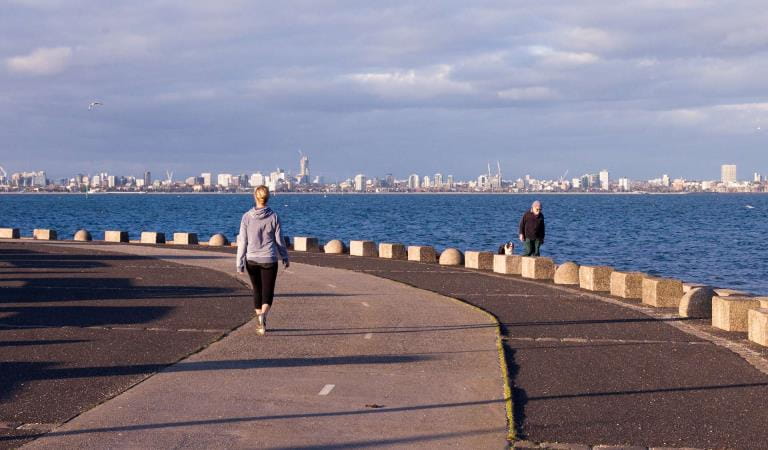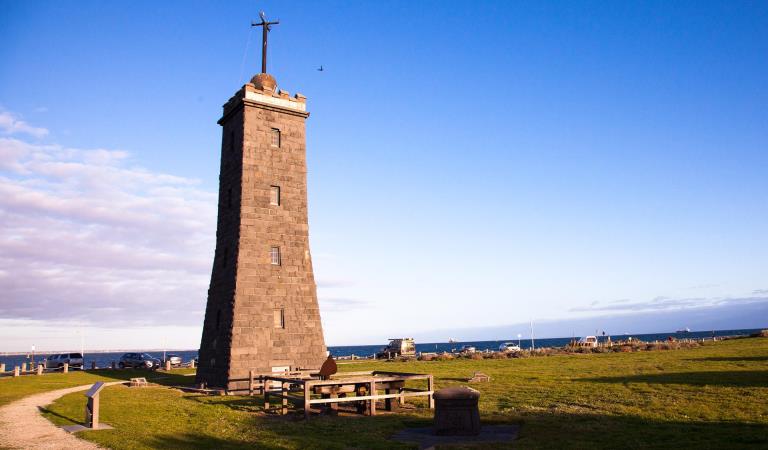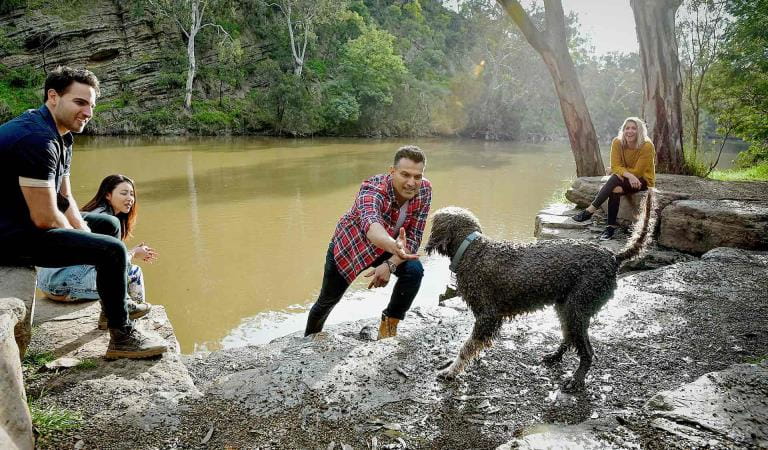Explore
Point Gellibrand Heritage Park
Point Gellibrand is one of Victoria’s richest heritage sites. It was Victoria’s first permanent European settlement and seaport. Visitors can explore the maritime history of Timeball Tower, retrace Ned Kelly’s steps along Battery Road, and enjoy the native revegetation projects.
Named Point Gellibrand by John Batman in 1836, the early quarry was a key source of bluestone for Melbourne’s first buildings, roads and piers. Convicts cut, transported and laid the rock and built the present-day Battery Road. It is widely rumoured that Ned Kelly worked on the retaining wall in 1873.
Following the discovery of gold in Victoria in the 1850s, Point Gellibrand was important for distributing goods within the colony, loading the sheep, wool and wheat which were to form the backbone of Victoria’s economy. In 1849, a Timeball Tower was built to aid ships in setting chronometers and navigating. The tower was moved to its current location in 1861, and remained in use until 1926. Visitors can also see the restored Fort Gellibrand (constructed 1860-1880) on open days and learn about the key role it played in the military, navy and governance of the colony.
150 years of industrial use damaged the ecology of Point Gellibrand, including the loss of sheoaks to firewood and boat-building, and impacts due to quarrying and soil compression. Extensive revegetation by local conservationists has helped to restore Shelley Beach and the fragile coastal ecosystem here. Plantings of Coastal Saltbush, Pigface, Knobby Clubrush and native grasses provide important habitat areas for the numerous wader birds that frequent the area.
Visitors to the park should check out the Lava Bubble at Shelley Beach. Keen birdwatchers and nature lovers alike will enjoy wandering or bike riding along the Bay Trail and take in this rich, revegetated landscape and waterside views. As this is a shared pathway, please be mindful of others on the trail.
Picknickers can enjoy a hot meal and keep warm in the cooler months by using gas and liquid fuel in portable barbeques, fuel stoves, burners or heaters. For safety reasons, glass bottles, glass container and glass utensils are not allowed at the Hanmer Street picnic shelter and dogs are not allowed at playgrounds.
Things To Do

The Bay Trail

Fort Gellibrand

Timeball Tower
Dog friendly parks
Your A-Z guide to Victoria's dog-friendly walking trails
Tours and adventure experiences in parks
One of the best ways you can get into nature is with a Licensed Tour Operator.
There are more than 400 Licensed Tour Operators across Victoria who are ready and waiting to help you experience and connect with Victoria’s spectacular parks and waterways.
Discover more than 60 different types of nature-based experiences including hiking, mountain biking, boating, four-wheel driving, indigenous culture tours, birdwatching, surfing, diving and so much more.
Licensed Tour Operators know all the best places to go and will plan and prepare your visit to ensure you are safe and can enjoy your nature-based adventure to the fullest.
How to get there
Point Gellibrand Heritage Park
Point Gellibrand is bounded by Kanowna Street, Fort Gellibrand, the Eastern Foreshore and the Dockyard. Access is via Battery Road, Williamstown.
There are carparks around Timeball Tower in the East, and the Quarry Picnic Area / Dolphin Playground in the West.
When you're there
Need to know
Point Gellibrand Heritage Park
Accessibility
The Bay Trail is wheelchair and pram accessible.
The nearest accessible toilets are located at the Quarry Picnic Area.
Visiting a park can be more of a challenge for people with disabilities, however in Victoria there are a wide range of facilities to help people of all abilities enjoy our wonderful parks around the state.
Assistance dogs are welcome in Parks Victoria parks and reserves. Entry requirements apply for parks and reserves that are usually dog prohibited, such as national parks.
How we keep it special
Marine national parks and sanctuaries exist to protect Victoria’s unique and diverse marine ecosystem, and the many plants and animals that live in them. People are encouraged to visit and be mindful to not have a negative impact on the area when enjoying these special places.
To protect and preserve marine biodiversity, any extractive or damaging activities (e.g. any type of fishing, collecting or taking of anything) is prohibited. This will help to maintain or enhance the condition of these areas.
All methods of fishing from the shore or at sea are prohibited, including fishing, netting, spearing, taking or killing of marine life. The taking or damaging of animals, plants and objects (artefacts) is also prohibited.
There are strong penalties under the National Parks Act for fishing in Marine National Parks and Marine Sanctuaries. To report a fishing offence call Fisheries Victoria on 13 FISH (13 3474).
Bicycle riding is a popular pastime, however, non-compliant electric bicycles and electric scooters are not allowed.
Parks Victoria Rangers and the local Friends of Point Gellibrand Coastal Heritage Park work hard to protect this special area. We conduct regular park and beach clean up events, and facilitate planting day activities. If you would like to get involved you can visit www.parkconnect.vic.gov.au.
As per the Crown Land (Reserves) (Metropolitan and Regional Parks) Regulations 2023, areas of Point Gellibrand Heritage Park are set aside for the activities specified or the prohibition or restriction of access, in accordance with the conditions, as indicated in the Set Asides. Please refer to the Set Aside(s) for Point Gellibrand Heritage Park.
Projects
We’re planning to bring the historic sea wall at Point Gellibrand Heritage Park back to life as part of the $21 million Urban Parks Active Wellbeing Program.
We will either repair or reconstruct the sea wall in 2022, following structural and technical investigations and obtaining relevant permits.
Learn more about the Urban Parks Active Wellbeing Program project.




